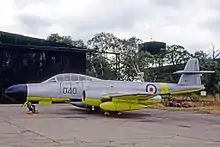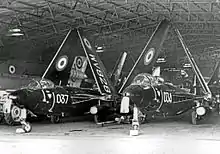Fleet Requirements Unit
The Airwork Fleet Requirements Unit (FRU) was a civilian-operated unit of the Royal Navy's Fleet Air Arm managed by Airwork Limited.[1] It was established on the 1 September 1952, at Hurn Airport, operating for 20 years before merging with another unit to become the Fleet Requirements and Air Direction Training Unit (FRADTU), on the 1 December 1972.[2]

History

Airwork Limited, referred to as Airwork Services Limited from 1957 for defence support work, secured a contract in September 1952 with the Royal Navy, to operate the Fleet Requirements Unit (FRU) at Hurn Airport, situated on the edge of Hurn village, 4 miles (6 km) north of Bournemouth. It used ex-Fleet Air Arm aircraft as targets to provide training for Royal Navy radar operators, however, civilian pilots were employed to fly the aircraft.[3]
Recently retired Fleet Air Arm de Havilland Sea Mosquito aircraft began arriving for use in August 1952. These were later replaced during 1953 by de Havilland Sea Hornet aircraft.
The Fleet Requirements Unit's tasks were expanded to include all aspects of Fleet requirement duties.[1] For example, this included target towing for gunnery purposes,[4] and not only for UK based destroyers and frigates, but also eventually required to support training for the Mediterranean based Fleet,[5] following the disbandment of 728 Naval Air Squadron at RNAS Hal Far (HMS Falcon), on Malta, in 1967, which had previously provided Fleet Requirement support for that area.[1]
Hawker Sea Fury, a fighter aircraft, which was the last propeller-driven fighter to serve with the Royal Navy, were acquired in 1955. However, the initial jet aircraft type used by FRU was the Supermarine Attacker, a single-seat naval jet fighter, which were also received in 1955, but these only lasted at Hurn for a couple of years.[6] These jets were followed at the FRU by Hawker Sea Hawk, a single-seat jet day fighter aircraft. Modifications for FRU work included a Harley Light being fitted into the nose of the port underwing fuel tank and each aircraft received a distinctive all-over gloss black paint scheme.[4]
The unit primarily used fixed-wing aircraft, however, Westland Dragonfly helicopters were operated between 1958 and 1961.[5] Target towing was undertaken using Gloster Meteor aircraft, acquired from 1961. These were the TT.20 variant, a high speed target towing conversion of the mark NF.11. The following year saw the last of the Sea Fury leave Hurn and from this point the FRU operated solely with jet aircraft.
June 1966 saw Supermarine Scimitar aircraft arrive, a single-seat naval strike aircraft, but by 1970 these were completely retired, due mainly to difficulties in keeping them operational. 1969 saw the withdrawal of the Sea Hawk aircraft from FRU duties,[4] however, Hawker Hunter aircraft arrived that year. A manoeuvrable day interceptor aircraft, initially single-seat GA.11 variants were operated, and later, two-seat T.8C mark were acquired. English Electric Canberra TT.18 target tug variant, a conversion of B.2 aircraft, were received in September 1969, these replaced the Gloster Meteor aircraft, which were withdrawn, on target towing duties.[7]
In December 1970 the unit started to operate a detachment of de Havilland Sea Vixen aircraft at RNAS Yeovilton (HMS Heron),[1] sited a few miles north of Yeovil, in Somerset. In October 1972 the unit moved to Yeovilton, where, albeit operated separately, it worked alongside Airwork Services’ Air Direction Training Unit (ADTU). The FRU and ADTU were merged into a single unit on the 1 December 1972, creating the Fleet Requirements and Air Direction Training Unit (FRADTU).[6]
Aircraft flown

A number of aircraft types and variants were used over the years at Hurn by Airwork Services, operating as the FRU:[5][6]
- de Havilland Mosquito PR.16 (1952 - 1953)
- de Havilland Sea Mosquito TR.33 (1952 - 1953)
- de Havilland Sea Hornet F.20 (1953 - 1955)
- de Havilland Sea Hornet NF.21 (1953 - 1955)
- Hawker Sea Fury FB.11 (1955 - 1962)
- Supermarine Attacker FB.2 (1955 - 1957)
- Hawker Sea Hawk F.1 (1956 - 1958)
- Fairey Firefly TT.4 (1957 - 1958)
- Hawker Sea Hawk FB.5 (1958 - 1963)
- Westland Dragonfly HR.3 (1958 - 1961)
- Gloster Meteor TT.20 (1958 - 1971)
- Hawker Sea Hawk FGA.6 (1961 - 1969)
- Gloster Meteor T.7 (1962 - 1971)
- Supermarine Scimitar F.1 (1965 - 1971)
- Hawker Hunter T.8C (1969 - 1972)
- Hawker Hunter GA.11 (1969 - 1972)
- English Electric Canberra TT.18 (1969 - 1972)
- English Electric Canberra B.2 (1969 - 1972)[1]
- English Electric Canberra T.4 (1969 - 1972)[1]
- de Havilland Sea Vixen FAW.2 (1970 - 1972)[1]
References
Citations
- Ballance 2016, p. 411.
- "Airwork FRU". www.wings-aviation.ch. Retrieved 11 April 2023.
- "Airwork Woolleyfamily". www.woolleyfamily.co.uk. Retrieved 11 April 2023.
- "Naval Air History". navalairhistory.com. Retrieved 12 April 2023.
- "Hampshire Airfields". www.hampshireairfields.co.uk. Retrieved 11 April 2023.
- "FRADU Hunter history". www.fradu.info. Retrieved 11 April 2023.
- Thetford 1991, p. 425.